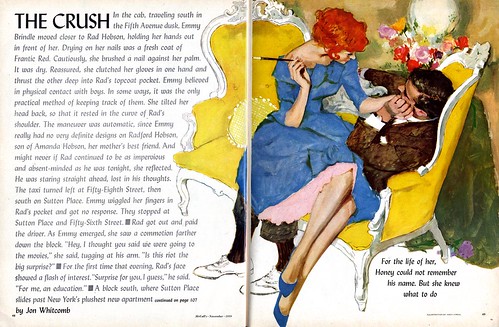
But at Rahl something was wrong. When Andy notified Phil (as soon as we bought our home) he would be vacating his NYC studio space to work from home, the normal discussion of a change in commission from "in-house" rate of 60/40 to "out-of-town" rate of 70/30 unexpectedly turned into a contentious battle.
The only way I can guess why it occurred revolves around the contract Andy had received well before we moved for a dozen McCall’s magazine illustrations. A rare and big deal. It is my belief that the idea of cutting into some of his commissions made Rahl balk. He refused to discuss the matter further.
But that was not all he did. When it came time for him to pay Andy’s current $5000 in commissions, he withheld it. For the first time ever, we had to borrow $1000 for our 3 basic appliances from my kind friend (the same fellow who had served as my ‘cover’ when I was surreptitiously seeing Andy). And we proceeded to limp along on what little we had left figuring all would soon be resolved.

After months when no payment of those commissions was forthcoming, Andy finally decided he had to file suit against Rahl for them. I agreed wholeheartedly. It was unconscionable. At that point, when the word spread in the studio this was occurring, one of the artists came to Andy to verify -- almost in a whisper -- that it was so. Of course, said Andy. The fellow then disclosed to Andy that Rahl had withheld some commission monies from him. For over a year or more . . . Our eyes widened. "And from some of the other guys, too," he lamely trailed off.
They did nothing about this thievery. It was lesser amounts than was owed Andy, so they meekly ‘took the hit and kept quiet.’ Once notice was served upon an incredulous Rahl that Andy was suing him and the wheels slowly began turning legally, Andy was warned one day that if he pursued this course he would never work in New York again!
At first this threat seemed silly bombast. Until the months -- and then the years unwound before us with barely any work at all! No matter how we tightened our belts, we could hardly live our modest life, for jobs seemed to slowly be going elsewhere. We were living below poverty level. I recall Andy could not afford to join the Society of Illustrators, no less indulge in the social activities they offered.
One odd occurrence relating to SOI was that they did hang an illustration of Andy’s on Park Avenue in one of their shows. It was of William F. Buckley, Jr. A small narrow but delicious painting he did as a sample. We were notified it was stolen right off the wall. Popped no doubt into an attache case or a portfolio. Later on, I urged Andy to do another one of it for it was one of my favorites. Even if neither of us liked Buckley’s political point of view, we savored his elegant use of the English language.

The 1960s were another kind of turning point in illustration art. Fewer pieces of fiction appeared in the women’s magazines. Usually there were at least three per issue. Photography was in the ascendancy, competition among the illustrators was stiff for the two per issue stories, then one per, and then even this well pretty much dried up. And later, when there was an upswing in art, it had evolved into quite different kinds from that of the ‘50s. Even advertising art was heavily using photographers.
Most New York illustrators saw the writing on the wall and gradually turned elsewhere to try to make a living in this new environment. I know few firsthand details of how others with Rahl managed except that Fred Siebel became an art director, Herb Saslow sold mutual funds and exhibited some of his surreal romantic paintings to a Pennsylvania museum. Spot man, Oscar Barshak always had depended primarily on his interior decorating. Dorothy Monet would undoubtedly come out on top . . . of whatever she chose to do. Just prior to that time, though, I think she had married a psychiatrist and had a baby. This downturn in illustration likely had little effect on her. And many years later, as I mentioned in Part 3, her writing abilities were displayed in the PBS program on Mary Cassatt.
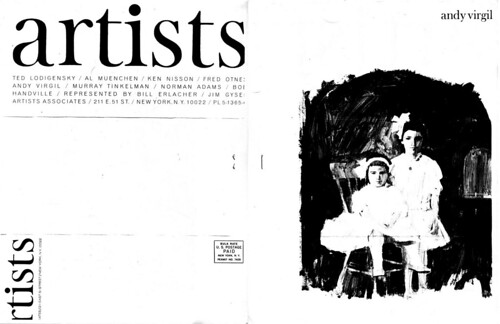
Some of the artists in the dry sixties banded together to create their own studios. Fred Otnes did. There was artists associates, who eventually took Andy. But he got almost no work through them. There was artists, inc., too. Slim pickings.
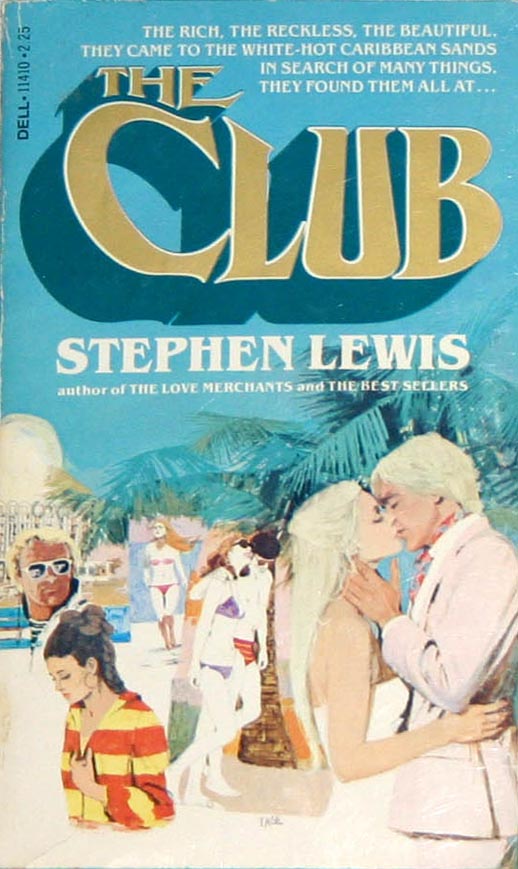
Through those years Andy created samples hoping to get work. Not a bad thing. Samples, for him, represented freedom from constraints. He did what he loved and the vitality and freshness, tenderness and beauty of them tells that story.

And, using them, he tried to obtain jobs in illustration, tried also to land a new rep which he did. Three times. But until he hooked up with Joe Mendola there was hardly enough work coming in to live on.
When I first sent examples of the broad spectrum of Andy’s work to Leif for the Today’s Inspiration project, this was his reaction: "I was stunned speechless. . . How could such a talent as Andy not have received more recognition? The work in this package. . . each piece more beautiful than the last. . ." And again, when he received more photos of Andy’s originals, he wrote he was "completely overwhelmed by the wealth of beautiful images . . ."
How could such a talent as Andy not have received more recognition?
That question nagged at my heart constantly, even as I became more and more disheartened at our grim "turn of luck." Far worse than the straits we were in, the most painful thing for both of us to accept was what was happening to one of his caliber. Andy was not a vain man. Not in the least. But he knew the value of his own ability. And I certainly was a realist and could compare what he did to the work of his contemporaries. It was even more chilling as the years ground us down, to harbor the thought we were being engulfed by the ghost of the McCarthy era when so many great talents were blacklisted . We hardly dared utter the word lest we sound paranoid. But it was the only thing that seemed to make sense.
Yet, good things did transpire, even in this lean time. Andy flew to Detroit in March of 1963 to judge an art director’s show with Bernie Fuchs and Art Director Clark Maddock. It was billed as Top Drawers in the Art Biz.

In June of 1963, our daughter, Jennifer Leigh Virgil, was born and Andy did many paintings of her, from earliest infancy into her teens (when he used her to illustrate an early ‘70s Literary Guild Doubleday job, The Cuppi, I shot the photos for it. Andy posed as the villain strangling Jen as his victim! )
A day or so after she was born, while I was in the hospital recuperating from Jen’s birth, Andy had gone to Lancaster, Pa. to shoot the auto races. As usual, totally absorbed in what he was doing, right down on the track shooting
the on-coming Formula 1s
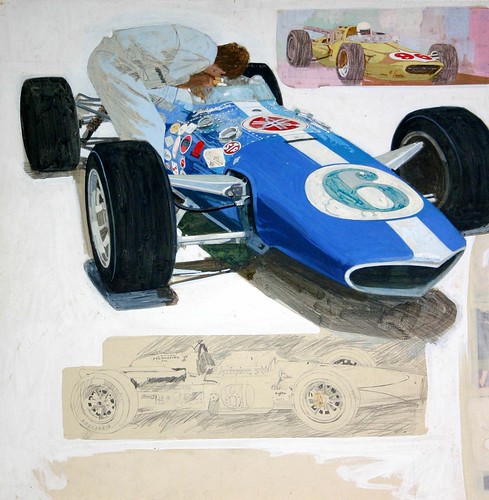
suddenly the pace car veered right towards him. Luckily for Jen and me, somebody shoved him and his Rollei out of the way. With casual relish, he told me that hair-raising tale when he came to visit wee Jen and me next day. The almost-widow and orphan.
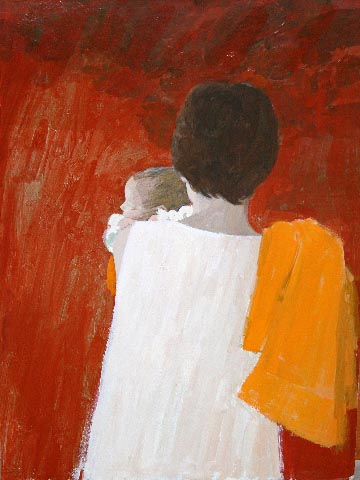
Most of the Jenny paintings were done as samples. Below is Jen at Old Rhinebeck Museum, New York.

But a couple ended up published: the American Airlines poster (see Part 4) and one used by Woman’s Own magazine out of London (below).
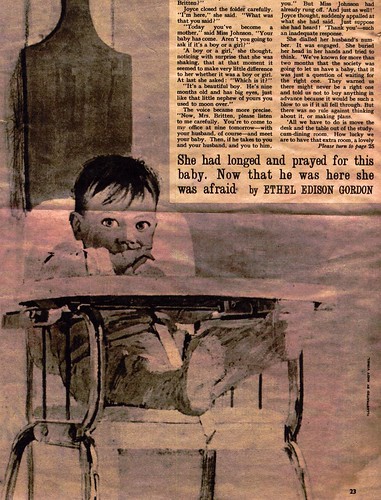
The following year, 1964, Andy was approached by an agent dealing in second rights for the European market. They paid very little -- but they paid.
Tomorrow: To London, To London!
Anita Virgil is an internationally anthologized haiku poet. She lives in Forest, Virginia.
Entire contents of these posts on Andy Virgil (both text and pictures) © 2007 Anita Virgil. Nothing may be reproduced without permission of the author.
* The selection of Andy Virgil's original art available from Graphic Collectibles has been expanded.
Great work, great week!
ReplyDeleteThanks Leif.
Tragic yet beautiful.
ReplyDeletePoor Andy's livelihood and success snatched away right when he was seemingly at the height of his talents. Criminal. Beautiful though, because his focus was shifted to those who matter far more than any carrier ever could – family.
This is by far the most moving week of inspiration ever. Thank you Anita, Leif and especially, thank you Andy.
I've been reading these entries in silence the past week -- enraptured in the story of Andy Virgil. Thanks, to Leif and, especially, Anita for sharing all this. All I can ask is please post more. This is food for the soul and I'll be checking back here over the weekend just to see if maybe more has been posted!
ReplyDelete